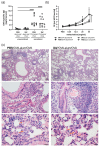Resolved Influenza A Virus Infection Has Extended Effects on Lung Homeostasis and Attenuates Allergic Airway Inflammation in a Mouse Model
- PMID: 33260910
- PMCID: PMC7761027
- DOI: 10.3390/microorganisms8121878
Resolved Influenza A Virus Infection Has Extended Effects on Lung Homeostasis and Attenuates Allergic Airway Inflammation in a Mouse Model
Abstract
Allergic airway inflammation (AAI) involves T helper cell type 2 (Th2) and pro-inflammatory responses to aeroallergens and many predisposing factors remain elusive. Influenza A virus (IAV) is a major human pathogen that causes acute respiratory infections and induces specific immune responses essential for viral clearance and resolution of the infection. Beyond acute infection, IAV has been shown to persistently affect lung homeostasis and respiratory immunity. Here we asked how resolved IAV infection affects subsequently induced AAI. Mice infected with a sublethal dose of IAV were sensitized and challenged in an ovalbumin mediated mouse model for AAI after resolution of the acute viral infection. Histological changes, respiratory leukocytes, cytokines and airway hyperreactivity were analyzed in resolved IAV infection alone and in AAI with and without previous IAV infection. More than five weeks after infection, we detected persistent pneumonia with increased activated CD4+ and CD8+ lymphocytes as well as dendritic cells and MHCII expressing macrophages in the lung. Resolved IAV infection significantly affected subsequently induced AAI on different levels including morphological changes, respiratory leukocytes and lymphocytes as well as the pro-inflammatory cytokine responses, which was clearly diminished. We conclude that IAV has exceptional persisting effects on respiratory immunity with substantial consequences for subsequently induced AAI.
Keywords: allergic airway inflammation; allergic asthma; influenza A virus; macrophages; pro-inflammatory cytokines; respiratory immune regulation.
Conflict of interest statement
The authors declare no conflict of interest.
Figures







Similar articles
-
GM-CSF treatment prevents respiratory syncytial virus-induced pulmonary exacerbation responses in postallergic mice by stimulating alveolar macrophage maturation.J Allergy Clin Immunol. 2016 Mar;137(3):700-9.e9. doi: 10.1016/j.jaci.2015.09.031. Epub 2015 Nov 10. J Allergy Clin Immunol. 2016. PMID: 26560044
-
Unique Transcriptional Architecture in Airway Epithelial Cells and Macrophages Shapes Distinct Responses following Influenza Virus Infection Ex Vivo.J Virol. 2019 Mar 5;93(6):e01986-18. doi: 10.1128/JVI.01986-18. Print 2019 Mar 15. J Virol. 2019. PMID: 30626665 Free PMC article.
-
Respiratory syncytial virus prevents the subsequent development of ovalbumin-induced allergic responses by inhibiting ILC2 via the IL-33/ST2 pathway.Immunotherapy. 2018 Sep;10(12):1065-1076. doi: 10.2217/imt-2018-0059. Epub 2018 Jul 20. Immunotherapy. 2018. PMID: 30027786
-
The Role of Innate Leukocytes during Influenza Virus Infection.J Immunol Res. 2019 Sep 12;2019:8028725. doi: 10.1155/2019/8028725. eCollection 2019. J Immunol Res. 2019. PMID: 31612153 Free PMC article. Review.
-
Mast cells and influenza a virus: association with allergic responses and beyond.Front Immunol. 2015 May 18;6:238. doi: 10.3389/fimmu.2015.00238. eCollection 2015. Front Immunol. 2015. PMID: 26042121 Free PMC article. Review.
Cited by
-
Airway-resident memory CD4 T cell activation accelerates antigen presentation and T cell priming in draining lymph nodes.JCI Insight. 2024 Dec 17;10(3):e182615. doi: 10.1172/jci.insight.182615. JCI Insight. 2024. PMID: 39688906 Free PMC article.
-
Infection-Associated Mechanisms of Neuro-Inflammation and Neuro-Immune Crosstalk in Chronic Respiratory Diseases.Int J Mol Sci. 2021 May 27;22(11):5699. doi: 10.3390/ijms22115699. Int J Mol Sci. 2021. PMID: 34071807 Free PMC article. Review.
-
Perinatal origins of chronic lung disease: mechanisms-prevention-therapy-sphingolipid metabolism and the genetic and perinatal origins of childhood asthma.Mol Cell Pediatr. 2021 Dec 20;8(1):22. doi: 10.1186/s40348-021-00130-y. Mol Cell Pediatr. 2021. PMID: 34931265 Free PMC article. Review.
-
Antiviral Activity of a Cyclic Pro-Pro-β3-HoPhe-Phe Tetrapeptide against HSV-1 and HAdV-5.Molecules. 2022 May 31;27(11):3552. doi: 10.3390/molecules27113552. Molecules. 2022. PMID: 35684487 Free PMC article.
-
Altered ontogeny and transcriptomic signatures of tissue-resident pulmonary interstitial macrophages ameliorate allergic airway hyperresponsiveness.Front Immunol. 2024 Jun 25;15:1371764. doi: 10.3389/fimmu.2024.1371764. eCollection 2024. Front Immunol. 2024. PMID: 38983858 Free PMC article.
References
LinkOut - more resources
Full Text Sources
Research Materials

